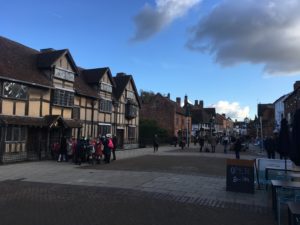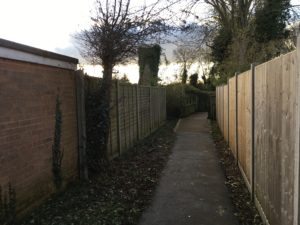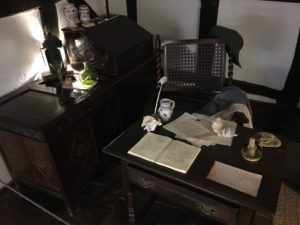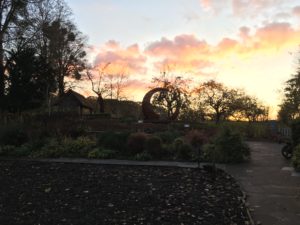“Genius. He’s a genius, the genius. The most human human there’s ever been. Always he chooses the best words. New, beautiful, brilliant words.” -David Tennant as the Doctor.

After a lazy start to the morning on account of catching up on sleep as we adjusted to the time change and jet lag, we headed north from Bourton-on-the-Water towards Stratford-upon-Avon to, naturally enough, explore some sites related to the life of William Shakespeare and Anne Hathaway. After a lovely little breakfast at a quaint tea room called Bensons (£5 for a sausage sandwich and tea), we first explored Shakespeare’s house.
Before entering the house proper, we were treated to a small museum that was actually a little underwhelming. The only part that was actually impressive was viewing a copy of The First Folio, which happened to be opened to Richard III (which is the play we’ve booked tickets for at the Globe in London). Otherwise, it was mainly a collection of forgettable items like photographs of statues of Shakespeare on display in various locations around the world, including—of all places—Alabama.

The actual house where Shakespeare was born, however, was actually pretty neat to see, but at the same time it also felt ever so slightly underwhelming. In fact, if it weren’t for the knowledgeable docents telling stories of what life was like living in this house (talking about, for example, how beds used to be suspended off the floor by carefully lacing ropes through a wooden frame and demonstrating how the ropes would needed to be tightened once or twice a week using a special wooden tool), then I probably would have been quite bored. The house itself was relatively unremarkable (and not surprisingly so, as the docent informed us that the Shakespeares were of the middle class—or rather—“middling sort,” as they would have said during Shakespeare’s time), so we saw the way of life of the most average person and not the most ostentatious prince. Even still, I’m happy I made the visit to the house, but if you have no interest in or desire to learn more about William Shakespeare, you may not want to go out of your way to come here.

We next went for a stroll to Anne Hathaway’s cottage. It’s about a mile long walk from Shakespeare’s house to Hathaway’s cottage, and it is a lovely, lovely walk that I do recommend, taking us from the town center (er, that’s centre, rather) through the busy High Street of Stratford and then through a quaint footpath that provides views of tiny gardens behind stone houses with thatched roofs and an open green space called Shottery Fields, to, finally on the edge of town, Anne Hathaway’s cottage. Upon reaching the cottage, we enjoyed views of an apple orchard on the site and mostly empty gardens that would normally at harvest time be overgrown with vegetable plants common to Hathaway’s time but in November revealed fertile, tilled soil.
The Hathaway cottage itself was, well, also pretty neat to see but also still slightly underwhelming, but—as with the Shakespeare house—not so underwhelming that it was disappointing. I’m happy I visited, but this will probably be the only time I ever set foot in these houses. What made these visits worthwhile, however, were the docents. The one we had at the Hathaway cottage was particularly good, an old lady who had no qualms making fun of her age (“Don’t feel like you have to stay in this room as I talk. There’s nothing worse than feeling like you’re chained to a room that you can’t escape from as an old biddy tells you about Elizabethan times.”) and who was filled with such knowledge of Anne’s marriage to William (“She was 25 and impregnated before marriage by a boy toy of 18. I’d like to think they created their first child al fresco in a corn field so as to not alert the locals of their illegal acts, but as I wasn’t there, I don’t wish to malign them.”) and the history of the ownership of the house and it’s grounds.

Following the tour of the Hathaway cottage, we made our way back to the town centre where we made a quick stop by Holy Trinity Church where Shakespeare was baptized and is buried. Sadly the church was closed by the time we arrived, so we couldn’t enter. But, it was still magnificent to see the larger-than-I-expected building from the 13th century silhouetted against a rapidly darkening sky, its stained glass windows glowing softly from warm light from within. Our final stop in Stratford was at a pub called the Dirty Duck located right on the River Avon (which was being visited by an elegant bevy of swans) where we enjoyed a wonderful dinner of ale pies.
Our journey continues tomorrow where we begin to make our way south towards Lytchett Matravers via Bath and Stonehenge.
